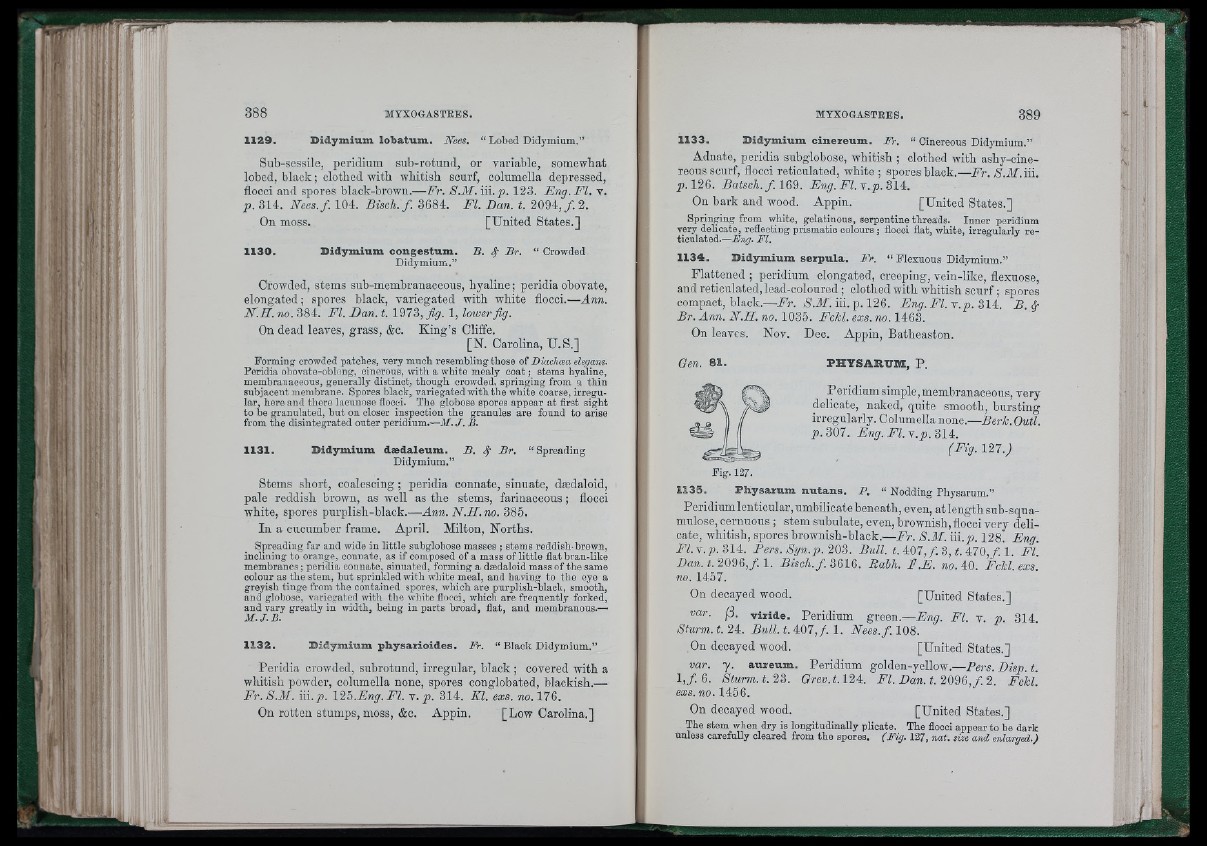
1 1 2 9 . D id ym ium lo b a tum . Nees. “ Lobed Didymium.”
Sub-sessile, peridium sub-rotund, or variable, somewbat
lobed, black; clotbed witb wbitisb scurf, columella depressed,
flocci and spores black-brown.— Fr. S .M .iii.p . 123. E n g .F l. v.
p . 314. Nees.f. 104. B isc h .f. 3684. Fl. Dan. t. 2 0 9 4 ,/. 2.
On moss. [United States.]
1 1 3 0 . D id ym ium c o n g e s tum .
Didymium.”
B. 4 Br. “ Crowded
Crowded, stems snb-membranaceous, byaline; peridia obovate,
elongated; spores black, variegated witb wbite flocci.—Ann.
N .H . no. 384. Fl. Dan. t. 1913, fig. 1, lower fig.
On dead leaves, grass, &o. King’s Cliffe.
[N. Carolina, U.S.]
Forming crowded patches, very much resembling those of Diaclicea elegans.
Peridia obovate-oblong, cinerons, with a white mealy coat; stems hyaalliini e,
membranaceons, generally distinct, thongh crowded, springing from a thin
subjacent membrane. Spores blaclc, variegated with the white coarse, irregular,
here and there lacunose flocci. The globose spores appear at first sight
to be granulated, but on closer inspection the granules are found to arise
from the disintegrated outer peridium.—M .J . B.
1131. D id ym ium dsedaleum.
Didymium.”
B . 4 B r. “ Spreading
Stems short, coalescing ; peridia connate, sinuate, dtedaloid,
pale reddisb brown, as well as the stems, farinaceous ; flocci
wbite, spores purplisb-black.—A n n .N .H .n o . 385.
In a cucumber frame. April. Milton, Norths.
Spreading far and wide in little subglobose masses ; stems reddish-brown,
inclining to orange, connate, as if composed of a mass of little flat bran-like
membranes; peridia connate, sinuated, forming a d*daloid mass of the same
colour as the stem, but sprinkled with white meal, and having to the eye a
greyisli tinge from the contained spores, which are purplish-black, smooth,
and globose, variegated with the white flooci, which are frequently forked,
and vary greatly in width, being in parts broad, flat, and membranous.—
M .J .B .
1 1 3 2 . D id ym ium p h y sa z io id e s . Fr. “ Black Didymium.”
Peridia crowded, subrotund, irregular, black ; covered witb a
whitish powder, columella none, spores conglobated, blackish.—
F r .S .M . iii.)). 125.Eng. Fl. r .p . 314. Kl. exs. n o .116.
On rotten stumps, moss, &c. Appin. [Low Carolina.]
1 1 3 3 . D id ym ium c in e z eum . Fr. “ Cinereous Didymium.”
Adnate, peridia subglobose, wbitisb ; clothed witb asby-cinereous
scurf, flocci reticulated, white ; spores black.—Fr. N.M. iii.
p . 126. Batsch. f . 169. Eng. Fl. r .p . 314.
On bark and wood. Appin. [United States.]
Springing from white, gelatinous, serpentine threads. Inner peridinm
very delicate, reflecting prismatic colours; floooi flat, white, irregularly reticulated.—
Eng. Fl.
1 1 3 4 . D id ym ium se zp u la . A>. “ Flexuous Didymium.”
Flattened ; peridium elongated, creeping, vein-like, flexuose.
and reticulated, lead-coloured; clotbed witb whitish s c u rf; spores
compact, black.—Fr. S.M. iii. p. 126. Eng. F l. r .p . 314. B . /
Br. Ann. N.H. no. 1035. Fchl. exs. no. 1463.
On leaves. Nov. Dec. Appin, Batheaston.
Gen. 8 1 . PH Y SA R U ia , P.
Peridium simple, membranaceous, very
delicate, naked, quite smooth, bursting
irregularly. Columella none.—Berh. Outl.
p. 307. Eng. Fl. r .p . 314.
(Fig. 121.)
Fig. 127.
1135. P h y sa zum n u ta n s . P . “ Nodding Physarum.”
Peridium lenticular, umbilicate beneath, even, atlength sub-squa-
mulose, cernuous ; stem subulate, even, brownish, floooi very delicate,
whitish, spores brownisb-blaok.—Fr. S.M. iii.p. 128. Enq.
F l . r .p . 314. Pers. Syn. p. 203. Bull. t. 401, f.3 , t. 410 f . l F l
D a n .t .2 0 9 6 ,fl. Bisch. f . 3616. Babh. F .E . no. 40. Fchl. exs.
no. 1457.
On decayed wood. [United States.]
var. f3. v iz id e . Peridium green.—Eng. F l. r. p . 314.
Sturm, t. 24. Bull. t. 401, f. 1. N e es.f. 108.
On decayed wood. [United States.]
var. y. a u z eum . Peridium golden-yellow.—Pers. Disp. t.
1 ,/. 6. Sturm.t. 23. Grev.t. 124. F l. Dan.t. 2096, f . 2 . Fchl.
exs. no. 1456.
On decayed wood. [United States.]
The stem when dry is longitudinally plicate. The flooci appear to be dark
unless carefully cleared from the spores. (Fig. 127, nat. size and enlarged.)